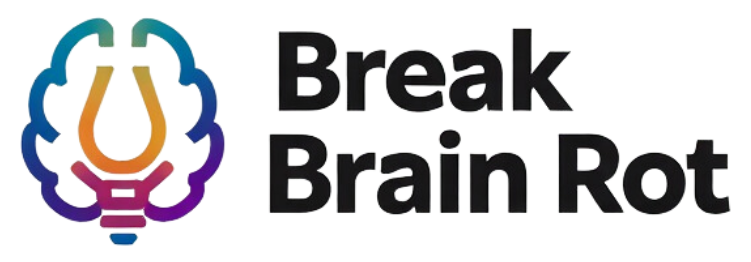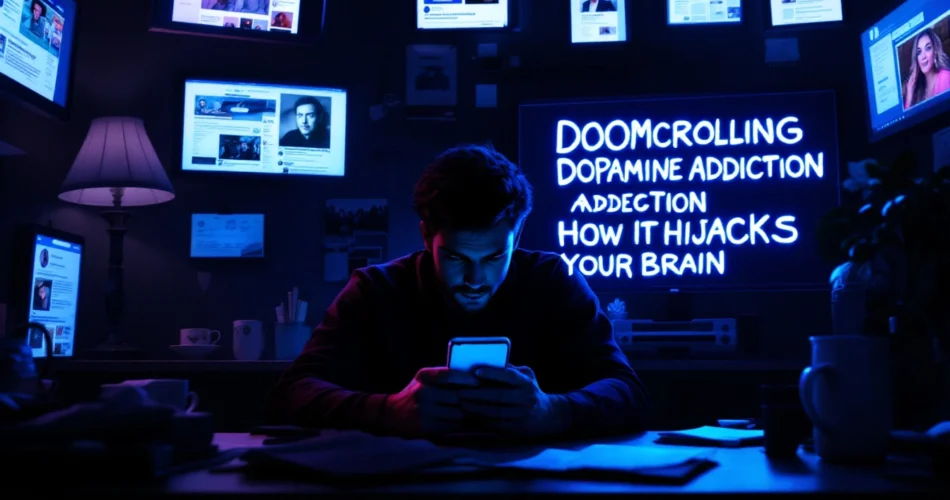Table of Contents
- What is Doomscrolling Dopamine Addiction?
- The Neuroscience Behind Doomscrolling and Dopamine
- Why Negative News Feeds Your Dopamine Habit
- Mental Health Consequences of Doomscrolling Dopamine Addiction
- Breaking Free from Doomscrolling Dopamine Addiction
- FAQs
- Conclusion
What is Doomscrolling Dopamine Addiction?
Definition and Rise of Doomscrolling
Doomscrolling refers to the compulsive consumption of negative or distressing information online, particularly on news sites and social media feeds. It became especially popular as a term during global crises, when people felt compelled to stay constantly updated. Unlike casual browsing, doomscrolling tends to focus on fear-inducing and anxiety-driven content.
How It Differs from Casual Social Media Scrolling
Regular scrolling may involve checking lighthearted updates, funny videos, or informative posts. In contrast, doomscrolling is often tied to stress-inducing content that makes you feel worse the longer you consume it. The key difference lies in the compulsive cycle—despite feeling drained and anxious, you struggle to put your phone down.
Why Experts Call It an Addiction
Just like gambling or overeating, doomscrolling can become addictive due to its reinforcement cycle. The brain gets a burst of dopamine from consuming new information, even when it’s negative. Over time, this cycle can create compulsive behaviors resembling addiction. Psychology Today highlights how compulsive digital behaviors mirror addictive patterns. For a deeper dive, see our guide on social media’s impact on mental health.

The Neuroscience Behind Doomscrolling and Dopamine
How Dopamine Rewards System Works
Dopamine is a neurotransmitter that plays a central role in motivation and reward. Whenever you encounter new, stimulating content, your brain releases small amounts of dopamine, encouraging you to keep seeking more.
The Feedback Loop Between Negative Content and Brain Chemistry
Ironically, negative content can be just as addictive as positive. Your brain seeks novelty and unpredictability, so that next alarming headline or shocking tweet becomes irresistible. This creates a feedback loop: distress leads you to search for more updates, and each new headline rewards that compulsion with dopamine.
Comparisons with Other Behavioral Addictions
Doomscrolling shares striking similarities with gambling, binge-watching, or even video game addiction. The National Institute on Drug Abuse emphasizes that intermittent reinforcement—rewards that come unpredictably—is one of the strongest addictive triggers. Learn more about this in our article on the science of digital addiction.
Why Negative News Feeds Your Dopamine Habit
The Brain’s Bias Toward Negativity
Humans evolved with a natural “negativity bias.” Focusing on potential dangers increased chances of survival. This wiring now manifests as a tendency to dwell on alarming content rather than positive material.
How News and Social Media Algorithms Amplify Doomscrolling
Social media algorithms are designed to keep you engaged. Bad news and shocking headlines generate stronger reactions, which means they’re more likely to appear in your feed. According to Pew Research Center, over half of Americans now consume their news primarily through social platforms—where algorithms curate content for maximum attention. For a breakdown, explore our article on social media algorithms explained.
Continuous Novelty and Intermittent Rewards
Every refresh or scroll promises something new—sometimes shocking, sometimes trivial. This mix of uncertainty and novelty mimics the psychological mechanics of slot machines, keeping you hooked despite knowing it’s draining.
Mental Health Consequences of Doomscrolling Dopamine Addiction
Anxiety, Stress, and Sleep Disruption
The most immediate effects of doomscrolling are heightened anxiety, stress, and difficulty falling asleep. Consuming alarming stories late at night spikes cortisol levels and prevents your brain from winding down.
Impact on Productivity and Focus
When your reward system is hijacked by endless news cycles, your ability to focus on work or studies decreases. You may find yourself distracted, mentally foggy, and less productive throughout the day.
Long-Term Risks to Emotional Regulation
According to the American Psychological Association, chronic exposure to negativity can alter emotional regulation and contribute to depression. For related insights, see our article on the effects of stress in the digital age.
Breaking Free from Doomscrolling Dopamine Addiction
Practical Strategies to Reduce Doomscrolling
- Set specific times for news consumption.
- Enable app timers to reduce mindless scrolling.
- Replace doomscrolling with uplifting or creative activities.
Mindfulness and Digital Detox Techniques
Practicing mindfulness strengthens awareness of your habits and creates a pause between impulse and action. Harvard Medical School research highlights mindfulness as an effective method to reduce compulsive behaviors. Explore our guide to digital detox practices for more ideas.
Setting Boundaries with Tech Tools and Apps
Digital wellness apps, screen-time limits, and “distraction blockers” can provide external support. Creating no-phone zones (like your bedroom) helps reinforce healthier habits.
Frequently Asked Questions
What makes doomscrolling dopamine addiction different from regular social media use?
Unlike casual scrolling, doomscrolling is compulsive and focused on negative content. Your brain receives dopamine spikes despite distress, reinforcing the behavior in an addictive loop.
Can doomscrolling permanently rewire the brain?
Extended doomscrolling can strengthen neural pathways associated with compulsive behavior, but with awareness and habit changes, the brain can adapt and recover.
What are the best strategies to stop doomscrolling at night?
Set a strict cutoff before bedtime, place your phone outside the bedroom, and replace the habit with reading or mindful practices.
Is doomscrolling linked to anxiety disorders?
Yes, research shows a direct correlation between excessive negative news consumption and rising anxiety levels. Doomscrolling can worsen pre-existing anxiety conditions.
How long does it take to break doomscrolling dopamine addiction?
It varies by individual, but many experts suggest about 21–30 days of consistent behavior changes are needed to rewire habits.
Conclusion
Doomscrolling dopamine addiction highlights just how easy it is for our attention and mental health to be hijacked by digital platforms. What starts as staying informed can evolve into disrupted sleep, heightened anxiety, and reduced productivity. The good news is that awareness is your greatest weapon. By understanding how doomscrolling and dopamine interact, you can take steps to break the cycle, set healthier boundaries, and reclaim control of your attention. Start today—your brain, body, and peace of mind will thank you.

